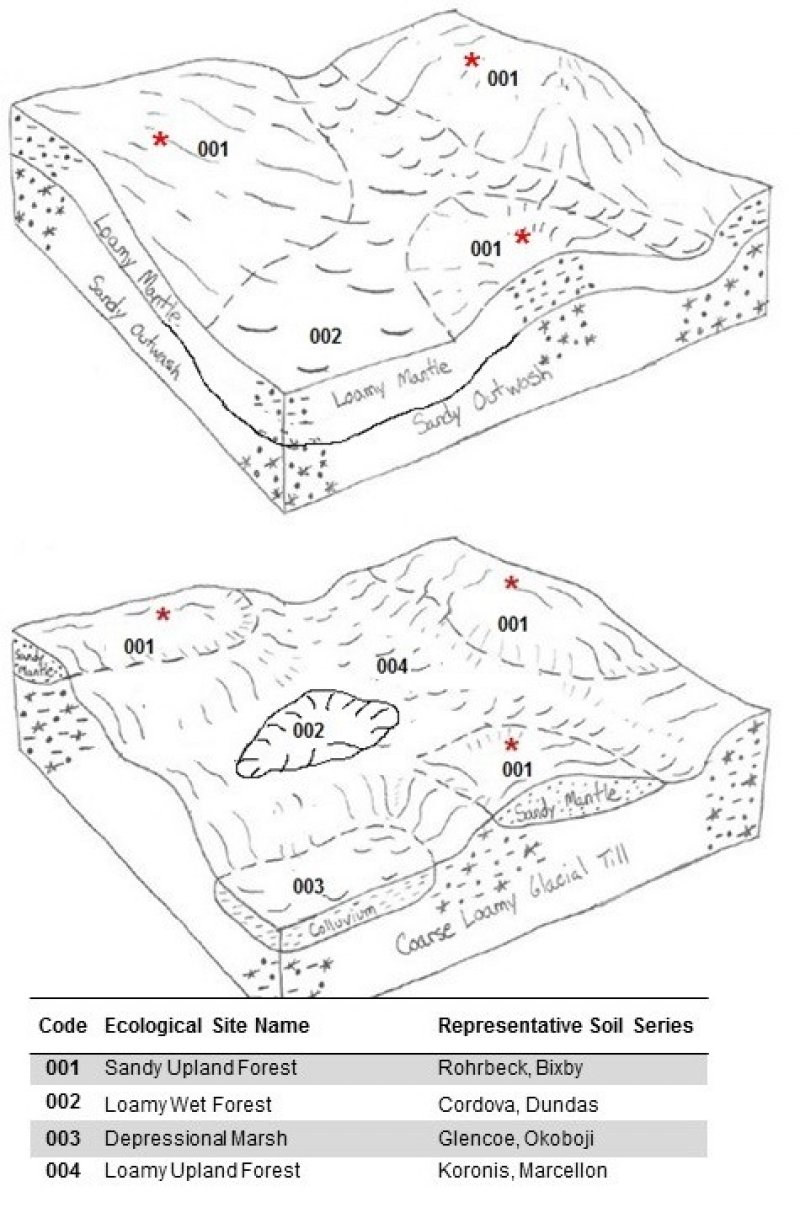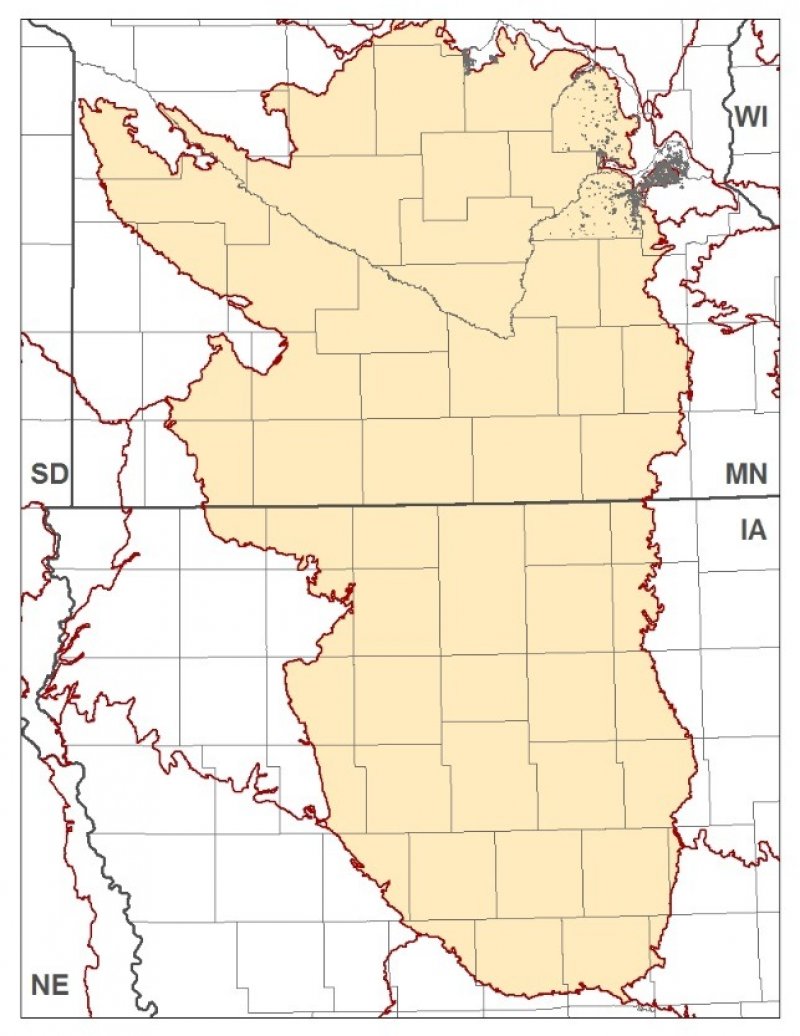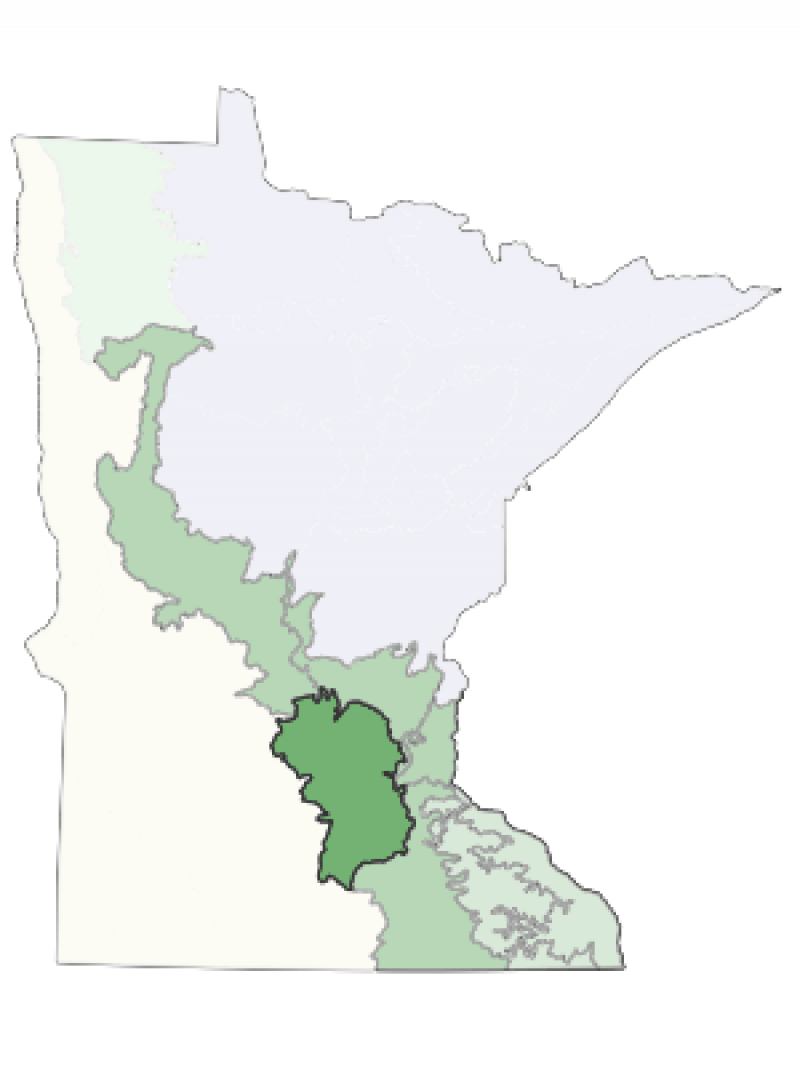Ecological dynamics
The Sandy Upland Forests Ecological Site has three states: the Reference State, the Tillage State, and the Disturbed Forest State.
The Reference State is a mature, deciduous forest with a substantial oak component. Small-gap disturbances occur naturally and result in a series of successional communities consisting of aspen, elm, sugar maple, elm, oak, and basswood. This ecological site can be affected by multiple natural triggers (disturbance processes) including wildfire, drought, insects, and windstorms. Wildfire intensity and frequency was historically reduced on this site due to topography and density of waterbodies.
The Tillage State is characterized by tillage and agricultural crop production. The two communities under this state are the Row Crop Community and the Seeded Grassland Community. Management inputs include preparing the site, seeding, fertilizing, controlling weeds and brush, and harvesting. Slope is a limiting factor on many areas.
The Disturbed Forest State is a wooded site that has undergone plant community changes due to disturbance. Triggers include tree removal, invasive plants, and unmanaged grazing. Often, these areas have been disturbed and exhibit an understory with non-native vegetation. These sites do have some soil, water, and wildlife benefits, but do not have the ecological stability or native plant diversity of a reference state.
The most common triggers on this ecological site are timber harvest or the transition of lower slope areas to agriculture. Once a reference state has been transitioned to a tillage field, the reversibility class is irreversible.
State 1
Reference State
The Sandy Upland Forests Reference State is a mature deciduous forest with canopy coverage ranging from interrupted to continuous (50-100%). Oak species include bur oak on drier areas within this site. More mesic areas will have northern red oak (Quercus rubra). Other canopy species include sugar maple (Acer saccharum), basswood (Tilia americana), white oak (Quercus alba), and American elm (Ulmus americana).
The shrub layer is patchy to interrupted (25%-75%) with variability influenced by soil characteristics, topography, and aspect. Common shrubs include chokecherry (Prunus virginiana), red elderberry (Sambucus racemosa), and prickly gooseberry (Ribes cynosbati).
The ground-layer consists of a variety of native forbs, ferns, and fern allies. Few high-quality reference sites remain in MLRA 103.
Resilience management. Resilience management practices include monitoring for invasive vegetation, applying herbicides as needed, and excluding grazing and logging.
Community 1.1
Reference Community
The Reference Community is characterized by multiple co-dominant canopy species, a substantial oak component, a moderate to dense shrub layer, and a diverse ground cover of native herbaceous species. Community composition will exhibit variation depending on slope, aspect, and available water capacity. Drier areas within this site will include bur oak. More mesic areas will include northern red oak. Other canopy species include sugar maple, basswood, white oak, and American elm. Natural small-gap disturbances within this community are filled with shrubs, tree seedlings, and tree saplings. These natural small-gap disturbances transition through successional plant communities. Oak, sugar maple, aspen, basswood, and elm are key successional species.
Resilience management. Resilience management practices include monitoring for invasive vegetation, applying weed control methods as needed, and excluding disturbances such as grazing and large-scale timber harvesting.
State 2
Tillage State
The Tillage State contains the Row Crop Community and the Seeded Grassland Community. This state describes areas currently in crop production or areas that were tilled but now are seeded to grass. Pathway mechanisms include preparing the site, planting desired species, applying herbicide, applying fertilizer, and harvesting. Higher sloping areas within this ecological site are not appropriate for row crop production. When the slope gradient exceeds 20 percent, row crop production is unfeasible due to the farm machinery limitations.
Soil tillage is the primary trigger to State 2. Tillage alters dynamic soil properties, including bulk density, structure, organic carbon content, and saturated hydraulic conductivity. Intensive tillage negatively impacts soil ecological functions. Conservation practices help mediate soil health impacts. Conservation tillage minimizes soil disturbance and improves soil structure and soil health. A cover crop rotation builds soil structure, improves infiltration rates, reduces runoff and erosion, and protects water quality.
Some areas within this ecological site have been converted to a warm-season grasses under the NRCS Conservation Reserve Program (CRP). Common species include big bluestem (Andropogon gerardii Vitman), switchgrass (Panicum virgatum L.), indiangrass (Sorghastrum nutans), and little bluestem (Schizachyrium scoparium). Plantings include perennial native forbs to benefit wildlife and pollinators. Leadplant (Amorpha canescens), common milkweed (Asclepias syriaca), butterfly weed (Asclepias tuberosa), hairy puccoon (Lithospermum caroliniense), asters (Aster spp.), gray goldenrod (Solidago nemoralis), New Jersey tea (Ceanothus americanus), and prairie clovers (Dahlia spp.) are native forbs suitable for sandy and loamy soils.
Non-native, cool-season grasses are also feasible. Species include brome (Bromus spp.), reed canarygrass (Phalaris arunidinacea L.), and Kentucky bluegrass (Poa pratensis L.). Seed mix selection will depend on landowner goals and objectives. Seeded grasslands are not as species rich or biologically diverse as native grasslands; however, they still offer ecological benefits for wildlife, especially grassland birds, water quality protection, and soil health.
Resilience management. Resilience management practices include common agricultural practices such as seeding, fertilizing, and managing invasive plants with herbicides or field cultivation. Prescribed fire is a resilience management practice on warm-season grasslands. Seeding, fertilizing, and controlling weeds and brush are resilience management practices for cool-season grasslands.
Community 2.1
Row Crop Community
Community 2.1 consists of intensive row crop agriculture. Soil tillage and intentional plant establishment are the primary triggers. The most common crops are corn and soybeans on an annual rotation. Many crops, however, are feasible for these areas. A secondary trigger is drainage modifications (ditching and tiling), which may be installed to improve soil drainage.
Conservation tillage practices may be implemented to reduce soil erosion while still maintaining a crop rotation. These practices protect the soil surface from erosion and allow water to infiltrate instead of running off. Examples include no-till or ridge-till, which leave residue on the surface of the field. Additional soil health benefits can be gained by adding alternative crops to fields that are already in conservation tillage. By diversifying the crop rotation, landowners take additional management steps to improve soil health and protect water quality.
Species may include legumes, clovers, beans, turnips, or small grains such as ryegrass, oats, rapeseed, winter wheat, winter rye, and buckwheat.
Resilience management. Resilience management practices include preparing the sites, planting, fertilizing, controlling weeds, and harvesting. The maintenance of the desired vegetation community is controlled by the intensity, frequency, duration, and timing of agricultural practices.
Community 2.2
Seeded Grassland Community
The Seeded Grassland Community grows in areas that were previously tilled and used for agricultural production, but have been transitioned to either warm-season or cool-season grasses. The primary trigger is the intentional establishment of a grass species. Warm-season grasses are commonly planted through conservation programs, such as the NRCS Conservation Reserve Program (CRP) as reflected in the conservation practices for the 2.1. pathway. Species include big bluestem, switchgrass, and Indiangrass. Also included are native forbs that benefit wildlife and pollinators. Numerous native grasses and forbs are suitable for these areas. Seed mix selection depends on landowner objectives and site-specific characteristics.
Poor grazing management practices on warm season grasslands can lead to soil erosion and invasion by cool-season grasses such as smooth brome (Bromus inermis) and Kentucky bluegrass (Poa pratensis). Resilience management practices include prescribed fire, invasive plant management, and a program of planned grazing that manages the intensity, frequency, and duration of grazing and the number of grazing animals.
Less common than warm-season species, but still feasible, are cool-season grass species such as Kentucky bluegrass and reed canarygrass. Many cool-season grasses can be planted, depending on landowner goals. Management inputs include seeding, fertilizing, and controlling weeds and brush. Resilience management practices include invasive plant management and a program of planned grazing. Many of these areas are eventually transitioned to annual crop production.
Resilience management. The resilience management practices may include planting desired species, managing grazing, mowing, fertilizing, and controlling unpalatable plant species.
Prescribed fire is a resilience management practice for warm-season grasslands. The controlled application of fire modifies vegetation structure and influence ecological processes.
Pathway 2.1A
Community 2.1 to 2.2
This pathway converts Community 2.1 (row crops) to Community 2.2 (seeded grassland). The primary mechanism of change is the seeding of desired grass species. This pathway is commonly triggered in conjunction with a conservation program such as the NRCS Conservation Reserve Program (CRP). The site is removed from crop production and seeded with warm-season grasses which benefit wildlife, soil health, and water quality. Cool-season grasses are also feasible. Numerous species may be planted. Legumes are commonly incorporated to improve forage nutrition. A small percentage of MLRA 103 currently supports cool-season grasses.
| Forage and Biomass Planting |
|
Pathway 2.2A
Community 2.2 to 2.1
This pathway describes the site transitioning from a seeded grassland to row crop agriculture. This is a common pathway throughout MLRA 103 as sites are placed in crop production. The mechanisms of change are tillage and intentional plant establishment (crop seeding). Resilience management practices include weed control (herbicide application), disturbance management (field cultivating), and harvest management.
State 3
Disturbed Forest State
The state has been disturbed and exhibits altered forest species composition. Numerous ruderal woodland and forest communities may occur on this ecological site depending on the type and severity of disturbances (selective harvest, grazing, invasive species), seed sources, and management activities. Fast-growing, shade tolerant tree species are typical in early successional communities. Numerous species of invasive plants may be present.
Community 3.1
Disturbed Forest Community
Community 3.1 is an altered forest community caused by previous or ongoing human disturbances. Invasive species are common in this community. Canopy composition varies depending on the severity and type of disturbance, community age, slope, aspect, available water, and seed sources. Oak species are often reduced on these sites due to harvesting and/or lack of successful regeneration. Invasive, non-native species are common on these sites and will continue to increase without management intervention.
Transition T1A
State 1 to 2
Transition T1A is the conversion of the Reference State to agriculture. The triggers are site clearing, soil tillage. and intentional plant establishment (crop seeding). Hydrological modifications, such as ditching and tiling, may be present. Slope is a limiting factor for this transition on many areas.
Constraints to recovery. Site clearing and soil tillage preclude recovery of the former state.
Transition T1B
State 1 to 3
Transition T1B is a transition from a mature deciduous forest to a disturbed (ruderal) forest. Triggers include timber harvest, surface site disturbance, grazing, and introduction of non-native species. The native plant community is altered, and these areas do not exhibit the ecological function or vegetative composition of State 1.
Restoration pathway R3A
State 3 to 1
Restoration to the reference state may be feasible with long-term management inputs including establishment of desired species, forest stand management (selective thinning), and control of invasive species. Triggers include intentional plant establishment (planting desired species), absence of disturbance (site protected from grazing and other site altering disturbances), stand improvement inputs, and eradication of invasive plant species.
| Brush Management |
|
| Tree/Shrub Site Preparation |
|
| Tree/Shrub Establishment |
|
| Forest Stand Improvement |
|
Transition T3A
State 3 to 2
Transition T3A is the transition of a disturbed forest state to agriculture production. This is a common pathway in MLRA 103. The mechanisms of change include site clearing, site preparation, tillage, and intentional plant establishment (crop seeding). Continued resilience management practices are necessary and include weed control (herbicide application), disturbance management (field cultivating), and harvest management.
Constraints to recovery. Soils tillage and the transition to agriculture preclude recovery of the former state.




